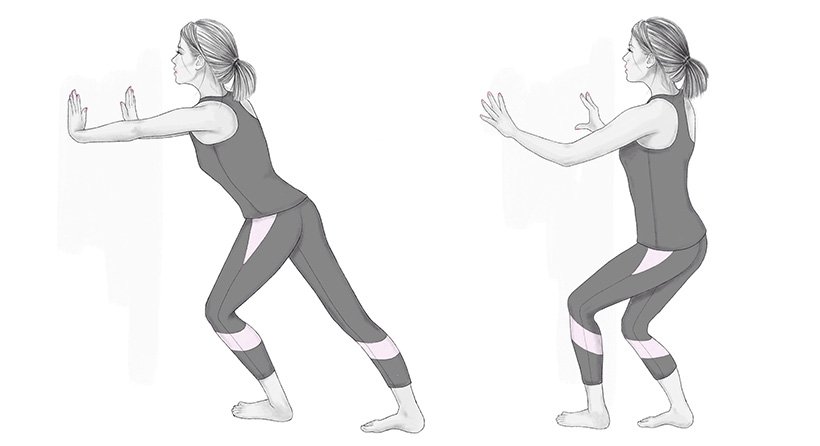Happy Feet
FOOT STRETCHES TO COUNTERACT HIGH HEELS
An important consequence of wearing high heels is a re-distribution of our body weight over the feet. On high heels, with the centre of gravity shifting forward, almost the entire body weight becomes concentrated on the inner side of the ball of the foot, instead of being spread evenly across the entire foot. As a result, the ball of the first and second toes experiences added pressure.
Michelle Rodriguez kicked off her career as a professional ballerina and scholarship student at The School of America Ballet, before throwing over her pointe shoes for the physical therapy program at Rutgers. For more than a decade, she’s been specializing in rehabilitation of professional dancers. Here, she shares some stretches to counteract the ill effects of high heels to keep the feet happy & healthy! (hey, all the more reason to wear flats between dance class and Milongas).
1) INSTRINSIC MUSCLES STRETCH
Prevents: Hammer toes, bunions, neuromas, and stress fractures.
Slip the fingers of the opposite hand in between your toes, as if you were to “shake hands” with your foot. Use fingers 2-5 to do this and leave your thumb out. By just holding your toes in this position, you will be stretching the muscles in between the long bones (metatarsals) of your foot. Hold this position for 30 seconds. Then pull the toes down so you stretch the top of the toes and foot. Hold the toes in this position for 5 seconds and repeat 10 times.
This stretch helps to create space in between each metatarsal and it helps to lengthen the toes.
2) FOOT/ANKLE EXTENSORS STRETCH
Prevents: Shin splints and stress fractures of the feet and shin bones.
Kneel down on both knees. Place a rolled up hand towel on the floor under your feet. Position the towel just under where your toes meet the top of your foot. Gently sit your hips back onto your heels until you feel a pull across the top of your feet and ankles. You may also feel the stretch up along the front of your shins. Hold this position for 30 seconds and repeat twice.
This will stretch the tendons and muscles along the tops of your feet and shins. It is important to stretch this area after dancing to help prevent shin splints and stress fractures of the feet and shin bones. This stretch will also open up the tops of your feet so they look nice in high heels.
3) PERONEALS STRETCH
Prevents: Poor foot and lower leg alignment, foot and ankle joint dysfunctions.
Lie on your back and place a strap (that does not stretch) around the ball of your foot. Lift your leg up while keeping the other leg down and extended along the floor. Pull your toes back towards you and then turn your foot inwards. Hold the strap with the opposite hand of the leg you are stretching. Try to bring your leg up and over, as if your foot is pointing up toward your opposite shoulder. In this position you should feel a stretch along the outside of your shin, your peroneal muscles. Hold this position for 30 seconds. Repeat twice on both sides.
This stretch creates length along your peroneals which you use a lot for jumping and running. Tightness through this area could lead to poor foot and lower leg alignment and also foot and ankle joint dysfunctions. It is important to stretch out your peroneals to maintain good alignment of your ankle.
4) CALF STRETCH
Prevents: Achilles tendonitis, plantarfasciitis, calf strains, or tears.
Stand in a lunge position with your hands against the wall, the front leg bent and the back leg fully extended. Position your back leg with a slight toeing-in posture. Make sure your heel stays connected to the ground. It should feel like you’re reaching your heel into the ground while maintaining your hips square to the wall and your back knee straight. Hold this position for 30 seconds. Then bring your back foot closer to the wall, so as to make your lunge slightly smaller, and bend your back knee while keeping your toes pointing slightly inward and your heel connected to the ground. Hold this position for 30 seconds. Repeat on the other side.
The first part of this stretches your gastrocnemius (calf muscle that flexes foot ) more, and the second part stretches your soleus (calf muscle that points foot )more. It is important to separately stretch these two muscles despite them coming together to form your Achilles tendon. We use our calves a lot to walk, run, jump, dance, rise up onto our toes, and they become shortened with prolonged use of high heels. By stretching out your calves properly, you can prevent Achilles tendonitis, plantarfasciitis, calf strains or tears.
5) FHL STRETCH
Prevents: Tendonitis or big toe problems.
Position your big toe up against a door frame or small ledge of the wall and slide it down so that the big toe is pointing upwards and the ball of the foot is trying to touch the floor. The other toes should be free and stretched out flat along the floor. Bend your knee and keep your heel on the ground. Make sure that as much of your big toe as possible is making contact with the wall and not just the very tip of it.
This stretches your FHL (Flexor Hallucis Longus), a muscle/tendon complex that runs from the tip of your big toe, under your foot, behind your ankle and up into your calf. The FHL is used a lot when pointing and pushing off with your toes in the dance. It is important to maintain adequate length through this stretch so you don’t develop tendonitis or big toe problems.
Illustrations by: Sally Faye Cotterill





